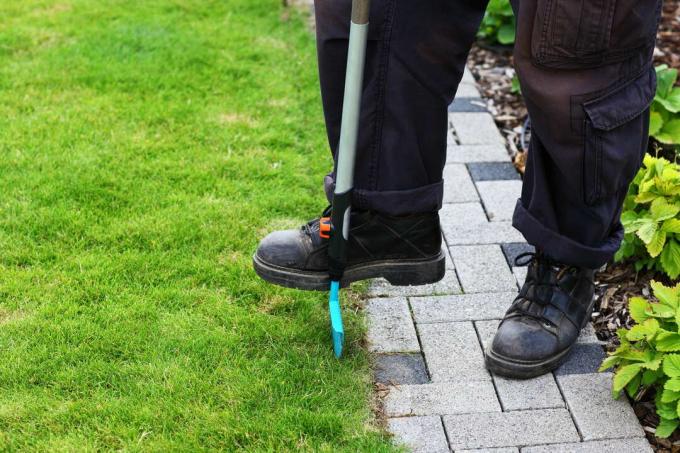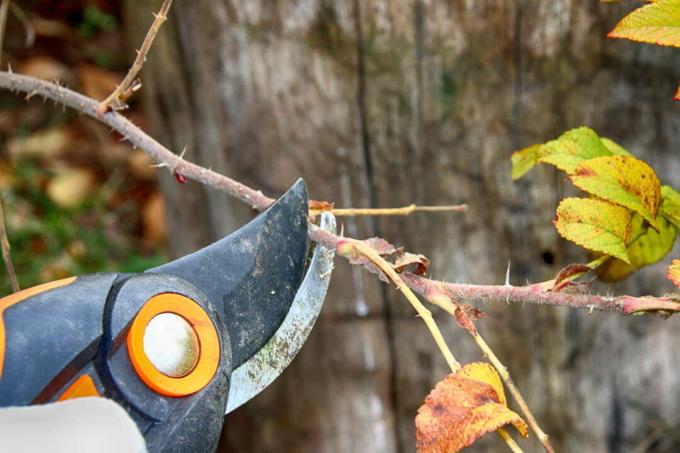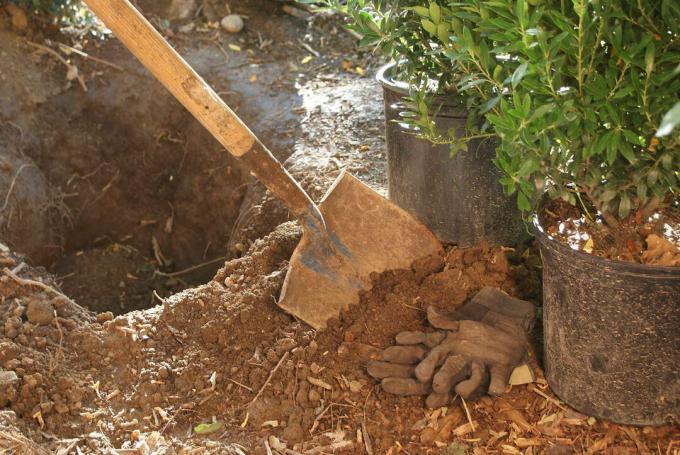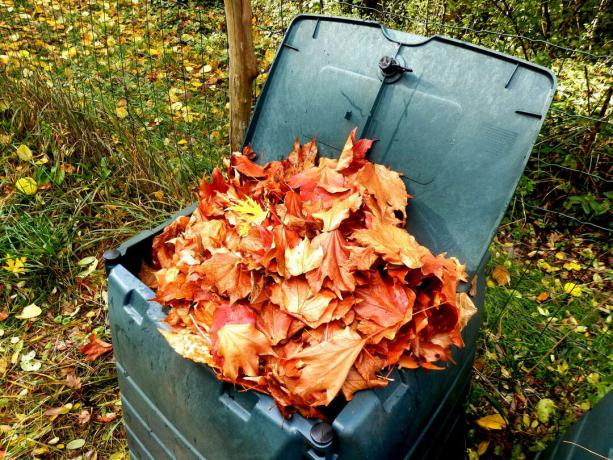Spring cleaning was yesterday, today it's autumn cleaning - we'll show you what you should do to prepare your garden for winter.

Sweep leaves, shape the lawn, or the first Prepare plants for overwintering - There is a lot to do in the garden in autumn. But the autumn cleaning not only ensures a tidy appearance, but also prepares the garden for the harsh winter. So that your garden can withstand the cold temperatures as well as possible, we will tell you which ten tasks should definitely be done in autumn.
contents
- Fall cleaning in the garden: These ten tips should be followed
- 10. Autumn cleaning tip: wood care
- 9. Autumn cleaning tip: trim the edges of the lawn
- 8. Autumn cleaning tip: lawn care and fertilization
- 7. Autumn cleaning tip: shape the hedges
- 6. Autumn cleaning tip: Prepare rose beds
- 5. Autumn cleaning tip: Protect sensitive plants
- 4. Autumn cleaning tip: clean gravel paths
- 3. Autumn cleaning tip: Whip up the perennials
- 2. Autumn cleaning tip: Use autumn leaves properly
- 1. Autumn cleaning tip: From leaves to compost
Fall cleaning in the garden: These ten tips should be followed
Even if the garden might be a little more work now, the autumn cleaning will be worth it next spring and you will be spared some work.
10. Autumn cleaning tip: wood care
Wind and weather affect our wood all year round, but the conditions for this are extremely unfavorable, especially in winter. So that fences, furniture and garden sheds can withstand moisture and frost, autumn is exactly the right time for a new protective coating. Glazes, varnishes or care oils give the wood the necessary resistance to survive bad weather without damage. When painting, however, make sure that the wood is completely dry and free the wood from dirt and old paint residues or smear films beforehand. Whether you work with lacquers, glazes or paints is usually a matter of taste, because all materials lead (if used correctly) to adequate protection. Only the brush is a must - since wooden objects in the garden usually have a coarser surface, a smooth foam roller would not work in the protective substances enough.

9. Autumn cleaning tip: trim the edges of the lawn
Before your lawn goes into the well-deserved winter break, it should get your attention one more time. The lawn edges in particular should now be cut off, otherwise the lawn will soon spread in flower beds or in the vegetable garden. The “English lawn edge” works best with an edge cutter, which cuts off a narrow piece of the lawn with a sharp edge. You can later remove this from the bed with a spade. For long, straight pieces it is worthwhile to stretch a cord or use a long lath as a template use: This way the edge is guaranteed to be clean and you don't get annoyed about curves and uneven spots Distances. Finally, the remaining root runners should be cut through with a cultivator or cultivator - this way you have some peace and quiet until spring.

8. Autumn cleaning tip: lawn care and fertilization
But not only the lawn edges require special care in autumn: the rest of the lawn also needs to be well prepared for winter. Especially after hot, dry summers, the lawn has often suffered and appears withered, brown and with unsightly bare spots. In addition to plenty of water, you should use an autumn lawn fertilizer like ours Plantura organic autumn lawn fertilizer used to prepare the lawn for the coming winter. The nutrients it contains optimally supply the lawn and help it regain its old strength. In addition, autumn lawn fertilizer contains an extremely high amount of potassium, which acts like a natural antifreeze and thus creates the best conditions for wintering. Like your Fertilize the lawn in autumn, find out here.

Even Scarifying helps the lawn by removing unpleasant competitors such as mosses or weeds. Bare spots should be sown again, if you still have pieces of the lawn edge, you can insert them and let them grow.
7. Autumn cleaning tip: shape the hedges
Hedges can be found in almost every garden, after all they not only look good, but also protect us from prying eyes. Unfortunately, many hedges quickly look neglected: especially summer-green, hardy deciduous trees such as field maple, hornbeam or red beech grow again enormously in late summer Day. Fortunately, you can easily prune the trees again in autumn and thus ensure more order in your garden. In fact, an autumn pruning has some advantages: On the one hand, the less leafy branches result in less clippings, on the other hand there is no risk of brooding ones Birds from their nesting sites. If you want to carry out a radical pruning, you have to wait until October anyway: Before that is the strong pruning prohibited by law to protect animals. In order for the plants to continue to grow well after the cut, however, you should also take into account the weather - dry days with overcast skies are ideal, but it shouldn't freeze.

6. Autumn cleaning tip: Prepare rose beds
The queen of flowers also has to be called to order in autumn, because intertwined twigs often form in densely planted rose beds over the summer. In order to put a stop to this chaos, it makes sense to shorten all new shoots of the rose by about a third and remove fallen leaves and twigs from the bed. Care should be taken to dispose of old leaves, especially if they are infested with star soot - Otherwise the fungal spores can overwinter on the leaves and attack the new leaves in the next year. Weeds should also be removed from the bed in order to optimally prepare the roses for winter. With a rose fork or a cultivator, the soil is thoroughly loosened again and then piled on the stem of the rose. It is important that the grafted area is also covered with grafted roses, as this is very sensitive. In addition, you can cover the bed with fir branches to protect it from severe frosts.

5. Autumn cleaning tip: Protect sensitive plants
In autumn it is time to protect the sensitive plants from the first severe frosts. Some plants, such as Geraniums (Pelargonium) or citrus plants (Citrus), cannot gain anything from the German winter and should rather spend the winter in the house. Other plants such as candles (Gaura) but can actually handle the cold temperatures well if they can get a little help. Particularly moist soil in combination with heavy frost are troublesome for the plant. Fortunately, a layer of mulch made of leaves combats both problems at the same time: On the one hand, the soil is insulated, and on the other hand, the rainwater is diverted from the leaves to the outside. Even hardy potted plants like Cherry laurel (Prunus laurocerasus) or boxwood (Buxus sempervirens) can overwinter outside - only your pot should be covered with fleece or styrofoam, otherwise it will freeze through too quickly.

4. Autumn cleaning tip: clean gravel paths
Even gravel paths are not spared from leaves in autumn and have to be cleaned. But the careful cleaning of your path not only brings order to the garden - the autumn cleaning also ensures clean paths in the long term. If the leaves remain in the gravel over the winter, humus slowly forms between gravel and gravel, which is an ideal breeding ground for weeds and is difficult to remove from the gravel can. Therefore, professionally laid gravel paths should also be freed of leaves and plant residues in autumn in order to remain permanently weed-free. This is best done in dry weather and with a leaf blower: the dry leaves are blown to the side by the outflowing air and only the clean gravel remains.

3. Autumn cleaning tip: Whip up the perennials
There is always something going on in the perennial bed: The perennial plants often develop a life of their own over the course of the year and some expand, while others gradually disappear. Autumn is therefore exactly the right time to intervene and bring order back to bed. Plants that have overgrown can be divided or removed completely and replaced by less vigorous plants. Older perennials can also benefit from a division and then bloom significantly more and more vigorously in spring. In any case, sick plants should be removed immediately - if they were to remain in the bed over the winter, the disease could spread to other plants and infect them.

2. Autumn cleaning tip: Use autumn leaves properly
In autumn no garden owner can complain about not enough leaves. But the colorful leaves are not only additional work, they can even be really useful. For example, as already mentioned, leaves can be used as natural frost protection for sensitive plants. But you can also do animals in the garden a favor with the leaves: In a quiet corner of the garden, a pile of leaves offers great winter quarters for hedgehogs.
More ideas and tips for using Autumn leaves in the garden can also be found in this article.

1. Autumn cleaning tip: From leaves to compost
There is another way to continue using the foliage in the fall: this is easy to do and win valuable humus free of charge, which provides a perfect nutrient base for many plants. Since the domestic composter is sufficient for the amount of leaves in larger gardens, there is a simple trick to build your own compost bin. To do this, just take a piece of rectangular wire mesh and shape it into a cylinder by connecting the beginning and end. Set up in a shady place, the leaves can now be poured in, compost accelerator is mixed in in layers. Without any further action, good deciduous compost will be produced in this container within a year, which is well suited for soil improvement.
Note: The more natural your garden is, the easier it is for insects and other living things to feel comfortable in it. We therefore recommend that you do not be too strict about tidiness in the garden. If you still want to do more Garden animals in winter have a look at this article.
The classic garden animals naturally also include a large number of wild birds. These can also be supported with a near-natural garden - but also by offering birdseed. Especially in the cold winter months you can actively support the wild bird populations by offering a feeding station. Our Plantura scatter feed for example, offers species-appropriate, high-energy ingredients that bring a large number of garden birds through the barren winter.
